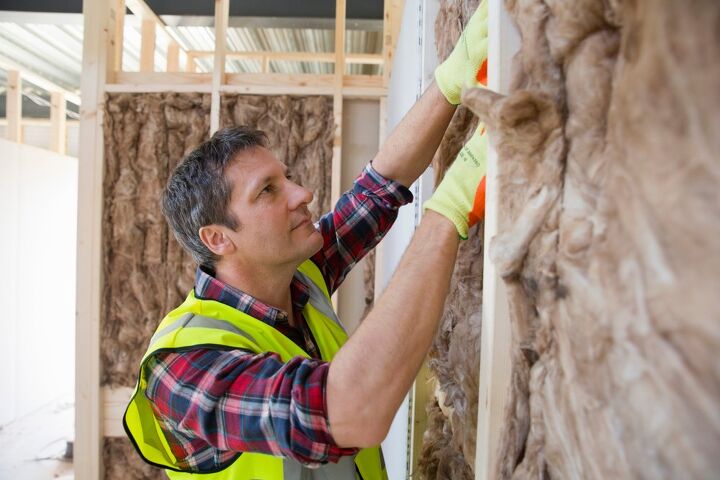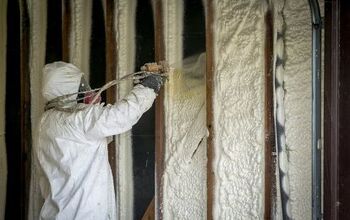Faced Vs. Unfaced Insulation: What's The Difference?

Insulation is an important part of every home. It keeps your house warm during the winter and cool during the summer. But insulation also reduces noise, thus increasing privacy.
Insulation is either faced or unfaced. Knowing the difference between the two helps determine the best location to install them. So, what exactly is the difference between unfaced and faced insulation?
Faced insulation has a vapor retarder to keep out moisture. This barrier usually consists of Kraft paper or plastic. Faced insulation is ideal for ceilings, floors, attics, finished basements, and exterior walls—anywhere moisture might seep in.
Though he doesn’t keep moisture away, unfaced insulation is non-combustible. Unfaced insulation is useful for noise reduction, energy conservation, and keeping pollutants out.
Related Content: What Size Staples For Insulation? | How To Keep Insulation From Falling Down | Spray Foam Insulation vs. Fiberglass | R13 vs. R15: Which Insulation Is Better?
Do You Need Insulation Installation or Replacement?
Get free, zero-commitment quotes from pro contractors near you.

The Importance of Insulation
The Environmental Protection Agency (EPA) states that installing insulation in your home can save an average of 11% on energy costs. Because insulation helps retain heat in the winter and cool air in the summer, you won’t need to crank the AC.
What Is Faced Insulation?
Usually, faced insulation is made out of fiberglass. Unlike unfaced insulation, faced insulation has a vapor retarder that keeps out moisture. The vapor retarder’s primary function is to keep moisture from spreading within the walls and throughout the house. This greatly reduces the risk of mold, mildew, or moisture damage.
Faced insulation can be used in several areas of a house, such as ceilings, floors, attics, finished basements, and exterior walls. It’s ideal for any areas in the house where moisture is likely to seep in.
What Is Unfaced Insulation?
Unfaced insulation is simply insulation without any vapor retardant, such as plastic or paper. In some areas, there are no codes in place requiring faced insulation. If this is the case for you, then you have your choice for which to install.
While unfaced insulation does not prevent the spread of moisture, it still offers many benefits.
- It reduces noise.
- It saves energy
- It retains heat in the winter and air in the summer.
- It keeps pollutants out.
Additionally, unfaced insulation is usually considered a non-c0mbustible material. It can help slow the spread of flames or prevent a fire altogether.
When To Use Faced vs. Unfaced Insulation
Because of their difference, faced and unfaced insulation cannot be used interchangeably. They require specific installation methods in specific areas of the house. The climate, in particular, plays a big part in how and where to install each type of insulation.
When to Use Unfaced Insulation
Between the two, unfaced insulation is a bit cheaper. Unfaced insulation costs $.10 to $.25 less per sq ft than faced insulation. It also creates better soundproofing.
However, unfaced insulation can be trickier to install because it doesn’t have a paper backing. During installation, it tends to tear more often than faced insulation. Sometimes, it’s possible to add your own plastic vapor barrier on unfaced insulation before installing drywall.
When to Use Faced Insulation
Faced insulation is typically used in first-time installations inside of various surfaces such as walls, ceilings, floors, and crawlspaces.
In cold climates, the paper layer should face the house’s interior. For instance, if you’re installing insulation in your crawlspace, then the paper needs to face upward toward your floors. Or, if you’re installing it in an attic, then it needs to face downwards toward your ceiling. In warm climates, the paper layer should face the house’s exterior.
Some areas require the use of faced insulation in order to keep things up to code. Always check with your local government for your area’s building code requirements.
Layering Faced and Unfaced Insulation
In some cases, you can use both faced and unfaced insulation. However, there’s a proper order to layering them, much of which depends on your climate. Here are some things to consider:
- Regardless of climate, you can always stack two layers of unfaced insulation without a problem.
- In cold climates, the vapor layer faces the interior. You cannot layer unfaced insulation over faced insulation in this case. The vapor layer would be trapped which could lead to mold and mildew growth. However, you can install unfaced insulation and layer faced insulation on top.
- In warm climates, the vapor layer faces the exterior. In this instance, you can install faced insulation and layer unfaced over top.
What is R-Value?
Insulation is rated based on R-value. R-value refers to a particular material’s performance as an insulator and how well it holds up to heat. Every material resists heat conduction differently, and that is what R-value denotes.
You can find the R-value of insulation materials right on the packing. Be sure to look for high R-values as that indicates that it is a better insulator.
How much insulation you need as well as the R-value of the materials depends on the climate of your zone. To make things easier, the Department of Energy divided the country into seven zones. Each has its own R-value requirements.
About The 8th Zone
It should be noted that the Department of Energy has actually applied the 8th zone for individual boroughs of Alaska. However, they do not denote the R-values differently for that zone currently. The 8th zone does not appear on the Department of Energy’s map, but it includes several boroughs, such as:
- Wade Hampton
- Nome
- Bethel
- Northwest Arctic
- Dellingham
This chart displays the R-value recommendation for different insulated areas of the home by zone.
ZONE | FLOORS | ATTIC | CRAWLSPACE | 2 x 4 WALLS |
1 | R25-R30 | R30-R49 | R13 | R13-R15 |
2 | R25-R30 | R30-R60 | R13-R19 | R13-R15 |
3 | R25-R30 | R30-R60 | R19-R25 | R13-R15 |
4 | R25-R30 | R38-R60 | R25-R30 | R13-R15 |
5 | R25-R30 | R49-R60 | R25-R30 | R13-R15 |
6 | R25-R30 | R49-R60 | R25-R30 | R13-R15 |
7 | R25-R30 | R49-R60 | R25-R30 | R13-R15 |
8 | R25-R30 | R49-R60 | R25-R30 | R13-R15 |
What Kind Of Insulation Is The Best?
There are several kinds of insulation; some of them are best suited for different uses. Each insulation has its own R-value as well as ideal function. The four main types of insulation include blown-in, foam spray, roll, and batt.
Roll and batt insulation are lumped together as Blanket insulation. However, there is one major difference. Roll insulation can be rolled out and cut, whereas batt comes in precut pieces that are installed separately.
You can find rolls and batts as either faced or unfaced with the R-value denoted on the packaging. Foam spray insulation is more costly than the other types. However, it’s also easier to apply than the alternatives. Blown-in insulation is easy to put in, but it does require that you have a blower.
This chart demonstrates the difference between each type of insulation and what it is best for.
Type | Best For | Material | Installation |
Blown-In | Can fill empty /hard to reach spots in walls and attic | Fiberglass, cellulose | Seal any air leaks and use a blower to blow in loose cellulose or fiberglass (cellulose as higher R-value) |
Foam Spray | Reaching spots around obstacles that Blanket insulation cannot reach | Isocyanate/polyol resin combination, polyurethane | Spray foam into a gap or cavity in layers allowing it to dry between each layer |
Roll | Stops spread of heat, best used in attics without existing insulation | Faced or unfaced fiberglass sheets | Cut to specific measurements of the space it is filling |
Batt | Stops spread of heat in walls, attics, in between wooden joists | Faced or unfaced fiberglass strips | Staple the flanges to framing to secure precut batts in place |
Different Insulation R-values
Besides having a distinct function, each material of insulation also has its own R-value. The following chart displays the R-value of some of the most widely available insulation materials.
Material | R-value |
Fiberglass and cellulose (blown-in/loose fill) | 30-50 |
Open-cell spray foam (Isocyanate/polyol resin combination, polyurethane) | 12.6 |
Closed-cell spray foam (Isocyanate/polyol resin combination, polyurethane) | 6.5 |
Fiberglass batt | 13-30 |
Insulation Safety
There are a number of precautions to take when dealing with insulation. They include things like wearing the proper gear and taking extra care during installation. Remember, it’s always best to call a professional if you don’t feel comfortable installing insulation yourself.
Make sure to fireproof.
Because faced insulation has a paper or plastic side, it’s considered flammable. If the vapor barrier is left exposed, then it poses a fire risk. To reduce the risk of fire, cover the faced insulation with a layer of drywall or sheetrock. You can also add another fireproof layer by layering unfaced insulation according to the directions above.
Avoid compressing the insulation.
Leaving the facing pointed towards the outside makes it exposed to heat and possible conduction. Whether it is faced or unfaced, avoid compressing fiberglass insulation. Compressing it will lose some of the insulation’s density and, in turn, lower the R-value.
Remember to insulate around pipes and wires.
If you’re insulating an area with pipes, then don’t forget to insulate around them! It is easy to forget sometimes, and it is not always easy insulating pipes. But this is where foam spray insulation comes in handy.
Wear eye and face protection.
It is extremely important to wear face and eye protection while applying foam insulation. Breathing in the chemicals in foam insulation or fiberglass causes asthma, long-term lung damage, scarring, and breathing troubles. Proper face protection is also critical when applying blown-in insulation. When using blown-in insulation, fiberglass particles are literally blowing all over the place.
Can You Increase The R-Value Of Your Insulation?
You can increase the R-value of your insulation somewhat, specifically, in exterior walls and attics. When insulating exterior walls, you can increase the R-value by adding sheathing to the insulation that’s already there. Nailing a layer of sheathing to external wall insulation can significantly increase the R-value.
To increase attic insulation R-value, all that you need to do is add an additional layer of insulation. When you do this, it helps retain heat within your home and save on energy.
You can also use foam board insulation for easy installation.
Do You Need Insulation Installation or Replacement?
Get free, zero-commitment quotes from pro contractors near you.

What Did We Learn?
The type of insulation that you use, its R-value, and how you apply it all affect the thermal shell of your home. Because of its vapor retardant, faced insulation protects your home from severe moisture damage, mold, and mildew. Unfaced insulation acts as a flame retardant because of its non-combustible qualities.
If you decide to stack your insulation, then make sure to pay attention to the orientation of the vapor layer. Then, you won’t risk trapping moisture. Whether you use faced or unfaced insulation, be sure to take proper safety precautions and pay attention to R-value. Lastly, always check with your local government for proper building code requirements.
Related Guides

We are a team of passionate homeowners, home improvement pros, and DIY enthusiasts who enjoy sharing home improvement, housekeeping, decorating, and more with other homeowners! Whether you're looking for a step-by-step guide on fixing an appliance or the cost of installing a fence, we've here to help.
More by Upgraded Home Team














![10 Best Cordless Leaf Blowers – [2022 Reviews & Ultimate Guide]](https://cdn-fastly.upgradedhome.com/media/2023/07/31/9070789/10-best-cordless-leaf-blowers-2022-reviews-ultimate-guide.jpg?size=350x220)

![Cost To Drill A Well [Pricing Per Foot & Cost By State]](https://cdn-fastly.upgradedhome.com/media/2023/07/31/9074980/cost-to-drill-a-well-pricing-per-foot-cost-by-state.jpg?size=350x220)










